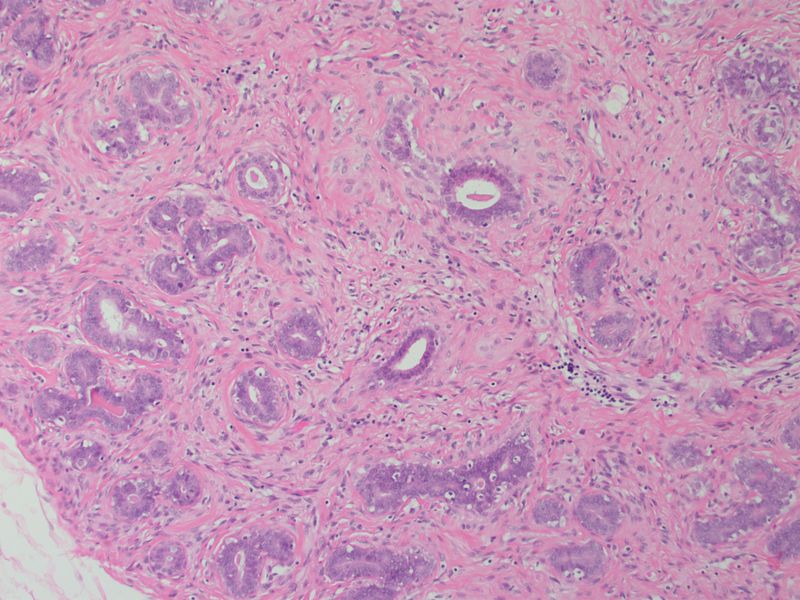Fibroadenoma pathophysiology: Difference between revisions
No edit summary |
|||
| Line 16: | Line 16: | ||
* The mediator complex subunit 12 (MED12) gene is the most common [[gene]] involved in the pathogenesis of fibroadenoma.<ref name="wiki">Fibroadenoma. Wikipedia (2015) https://en.wikipedia.org/wiki/Fibroadenoma Accessed on January, 29 2016</ref> | * The mediator complex subunit 12 (MED12) gene is the most common [[gene]] involved in the pathogenesis of fibroadenoma.<ref name="wiki">Fibroadenoma. Wikipedia (2015) https://en.wikipedia.org/wiki/Fibroadenoma Accessed on January, 29 2016</ref> | ||
==Associated Conditions== | ==Associated Conditions== | ||
* Carney's complex is | * Carney's complex is an uncommon medical conditions that may be associated with fibroadenoma of the breast. | ||
==Gross Pathology== | ==Gross Pathology== | ||
* On gross pathology, a painless, firm, solitary, mobile, and slowly growing breast [[lump]] is a characteristic finding of fibroadenoma. | * On gross pathology, a painless, firm, solitary, mobile, and slowly growing breast [[lump]] is a characteristic finding of fibroadenoma. | ||
Revision as of 16:29, 29 January 2016
|
Fibroadenoma Microchapters |
|
Diagnosis |
|---|
|
Treatment |
|
Case Studies |
|
Fibroadenoma pathophysiology On the Web |
|
American Roentgen Ray Society Images of Fibroadenoma pathophysiology |
|
Risk calculators and risk factors for Fibroadenoma pathophysiology |
Editor-In-Chief: C. Michael Gibson, M.S., M.D. [1] Associate Editor(s)-in-Chief: Haytham Allaham, M.D. [2]
Overview
Fibroadenoma is a common benign tumor of the breast. Fibroadenoma arises from connective tissue cells, which are cells that are normally involved in the functional and mechanical support of the surrounding tissues. Fibroadenoma demonstrate estrogen and progesterone sensitivity and may grow during pregnancy. The mediator complex subunit 12 (MED12) gene is the most common gene involved in the pathogenesis of fibroadenoma. On gross pathology, a rubbery, tan colored, and lobulated mass is a characteristic finding of fibroadenoma. On microscopic pathology, charectersitic findings of fibroadenoma include a biphasic proliferation of both stromal and epithelial components that can be arranged in two growth patterns; a pericanalicular growth pattern and an intracanalicular growth pattern.[1][2][3][4]
Pathogenesis
- Fibroadenoma is a common benign tumor of the breast.
- Fibroadenoma arises from connective tissue cells, which are cells that are normally involved in the functional and mechanical support of the surrounding tissues.
- The majority of fibroadenomas are benign and do not demonstrate any malignant potential.
- Fibroadenomas typically contain both stromal and epithelial connective tissue cells.
- Fibroadenoma demonstrate estrogen and progesterone sensitivity and may grow during pregnancy.[1][2][3][4]
- It is thought that the hormone-receptor mechanism mediates the excessive proliferation of epithelial and stromal cells.[5]
- Although fibroadenomas may be develop in any part of the breast, there is a significant predilection for the upper outer quadrant.
Genetics
- The mediator complex subunit 12 (MED12) gene is the most common gene involved in the pathogenesis of fibroadenoma.[1]
Associated Conditions
- Carney's complex is an uncommon medical conditions that may be associated with fibroadenoma of the breast.
Gross Pathology
- On gross pathology, a painless, firm, solitary, mobile, and slowly growing breast lump is a characteristic finding of fibroadenoma.
- Other charectersitic findings on gross examination of fibroadenoma include:[1][2][3][4]
- Rubbery texture
- Tan/white colored
- Lobulated appearance
- Short slit-like spaces present
- Calcifications
- Fibroadenomas may sometimes be referred to as a "breast mouse", owing to the high mobility of the tumor through out the breast tissue.
Microscopic Pathology
- An overgrowth of fibrous and glandular tissues
- A hypovascular, myxoid, and delicate intalobular stroma
- Calcification may be present
- Absence of mitotic figures, necrosis, and anaplasia
- Biphasic proliferation of both stromal and epithelial components that can be arranged in two growth patterns:
- Pericanalicular growth pattern: stromal proliferation around epithelial structures
- Intracanalicular growth pattern: stromal proliferation compressing the epithelial structures into clefts
- The table below differentiates between the four main subtypes of fibrodenoma according to microscopic histopathological analysis:[2]
| Fibroadenoma Subtype | Description |
|---|---|
| Juvenile fibroadenoma |
|
| Complex fibroadenoma |
|
| Myxoid fibroadenoma |
|
| Cellular fibroadenoma |
|
Gallery
Illustrated below is a series of microscopic images of fibroadenoma:[2]
References
- ↑ 1.0 1.1 1.2 1.3 1.4 Fibroadenoma. Wikipedia (2015) https://en.wikipedia.org/wiki/Fibroadenoma Accessed on January, 29 2016
- ↑ 2.0 2.1 2.2 2.3 2.4 2.5 Fibroadenoma. Libre Pathology (2015) http://librepathology.org/wiki/index.php/Fibroadenoma Accessed on January, 29 2016
- ↑ 3.0 3.1 3.2 3.3 Breast-nonmalignant-Fibroadenoma. PathologyOutlines (2015) http://www.pathologyoutlines.com/topic/breastfibroadenoma.html Accessed on January, 29 2016
- ↑ 4.0 4.1 4.2 4.3 Fibroadenoma. Radiopaedia (2015) http://radiopaedia.org/articles/fibroadenoma-of-the-breast-1 Accessed on January, 29 2016
- ↑ Sapino A, Bosco M, Cassoni P, Castellano I, Arisio R, Cserni G; et al. (2006). "Estrogen receptor-beta is expressed in stromal cells of fibroadenoma and phyllodes tumors of the breast". Mod Pathol. 19 (4): 599–606. doi:10.1038/modpathol.3800574. PMID 16554735.










